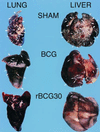Recombinant bacillus calmette-guerin (BCG) vaccines expressing the Mycobacterium tuberculosis 30-kDa major secretory protein induce greater protective immunity against tuberculosis than conventional BCG vaccines in a highly susceptible animal model
- PMID: 11095745
- PMCID: PMC17665
- DOI: 10.1073/pnas.250480397
Recombinant bacillus calmette-guerin (BCG) vaccines expressing the Mycobacterium tuberculosis 30-kDa major secretory protein induce greater protective immunity against tuberculosis than conventional BCG vaccines in a highly susceptible animal model
Abstract
Tuberculosis (TB) continues to ravage humanity, causing 2 million deaths per year. A vaccine against TB more potent than the current live vaccine, bacillus Calmette-Guérin (BCG), is desperately needed. Using two commercially available strains of BCG as host strains, BCG Connaught and Tice, we have constructed two recombinant BCG vaccines stably expressing and secreting the 30-kDa major secretory protein of Mycobacterium tuberculosis (M. tb.), the primary causative agent of TB. We have tested the efficacy of the two strains in the highly susceptible guinea pig model of pulmonary TB, a model noteworthy for its close resemblance to human TB. Animals immunized with the recombinant BCG vaccines and challenged by aerosol with a highly virulent strain of M. tb. had 0.5 logs fewer M. tb. bacilli in their lungs and 1 log fewer bacilli in their spleens on average than animals immunized with their parental conventional BCG vaccine counterparts. Statistically, these differences were highly significant. Paralleling these results, at necropsy, animals immunized with the recombinant BCG vaccines had fewer and smaller lesions in the lung, spleen, and liver and significantly less lung pathology than animals immunized with the parental BCG vaccines. The recombinant vaccines are the first vaccines against TB more potent than the current commercially available BCG vaccines, which were developed nearly a century ago.
Figures





References
-
- Dye C, Scheele S, Dolin P, Pathania V, Raviglione M C. J Am Med Assoc. 1999;282:677–686. - PubMed
-
- Cohn D L, Bustreo F, Raviglione M C. Clin Infect Dis. 1997;24:S121–S130. - PubMed
-
- Fine P E M. Rev Infect Dis. 1989;11, Suppl. 2:S353–S359. - PubMed
-
- Clemens J D, Chuong J H, Feinstein A P. J Am Med Assoc. 1983;249:2362–2369. - PubMed
-
- Colditz G A, Brewer T F, Berkey C S, Wilson M E, Burdick E, Fineberg H V, Mosteller F. J Am Med Assoc. 1994;271:698–702. - PubMed
Publication types
MeSH terms
Substances
Grants and funding
LinkOut - more resources
Full Text Sources
Other Literature Sources
Medical

